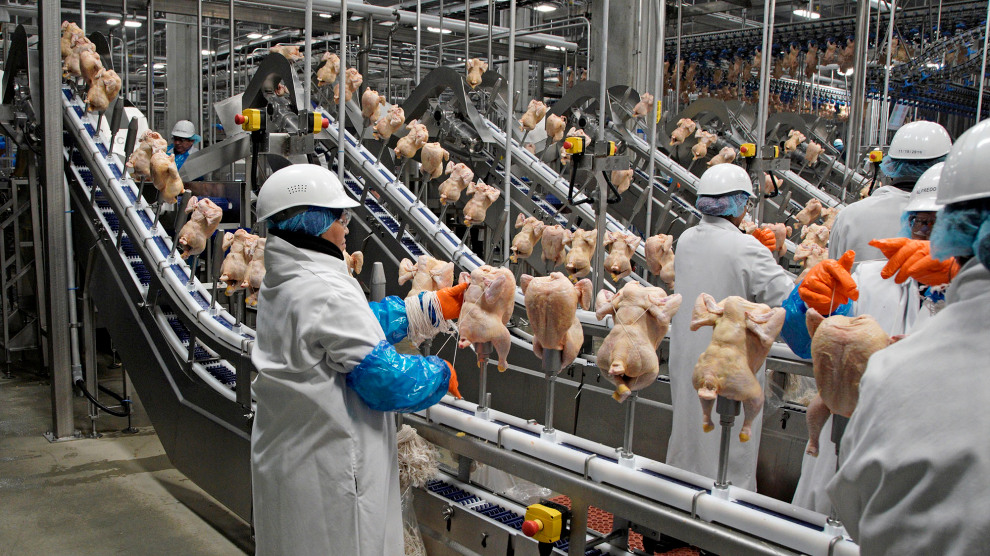
WASHINGTON—Dumping a GOP Trump regime decision that critics said endangered workers’ safety, the new Joe Biden-run Agriculture Department yanked the line speedup rule its predecessor planned for U.S. poultry processing plants.
The announcement cheered both the United Food and Commercial Workers, which represents tens of thousands of those workers, and the National Employment Law Project. Its attorneys fought on the workers’ side against USDA’s, particularly noting high line speeds endanger working women of color.
Poultry and pork processing workers, both groups UFCW represents, were subject to years of Trump USDA edicts, pushed by their bosses’ lobbies in the name of higher profit, which increased dangers on the job—and, in the case of pork, endangered consumers, too.
In the poultry plants, Trump’s USDA wanted to let bosses up line speeds from an already hazardous 140 birds per minute to an “impossible” 175, NELP safety and health specialist Deborah Berkowitz said. Biden dumped that proposed—not final–rule, which Trump’s USDA put out for public comment in late July. It had conducted experiments of higher speeds, using waivers, at selected plants.
Seeking millions of dollars in increased profits by forcing workers to process chickens, turkeys, and hogs at high line speeds, the plant bosses also put workers in danger of ergonomic (range-of-motion) ills and actual physical injuries, she noted.
“This is a true victory for all of the 250,000 poultry workers in the U.S.—the majority of whom are Black, Latinx, and immigrant workers—and for the coalition of worker rights, public health, consumer rights, and animal welfare groups that has fought the line speed increases for the past four years.
“The proposed line speed increases would have disproportionately harmed workers of color and their communities. Workers in the poultry industry already face injury rates 60% higher than the national average, and illness rates five times as high. And we know this is an undercount.”
The poultry processing magnates didn’t even listen when the Centers for Disease Control warned that higher speeds and lack of six-foot physical distancing within plants would drastically increase already high rates of coronavirus exposures, she said.
Biden’s order to USDA to dump Trump’s proposed rule “makes clear our critical supply chain industries— including grocery, health care, meatpacking, and food processing— must put their frontline workers first,” UFCW President Marc Perrone said in a statement.
“Even though it has been a week since his inauguration, President Biden is already showing the type of commitment to the health and safety of frontline food workers the American people expect and deserve, including actions to strengthen OSHA workplace safety enforcement and stop the dangerous push to increase poultry plant line speeds,” he added.
And Congress should ratify Biden’s withdrawal of Trump’s unlimited line speeds rule, Perrone added. It also should, as Biden wants, beef up OSHA inspections of poultry and pork processing plants, he said.
A NELP-provided chart shows how infections and injuries have shot up at plants that got waivers of the prior poultry processing speed limit. The Biden USDA’s decision still leaves pork plant workers vulnerable, and consumers, though.
Trump’s USDA not only let pork processors speed up their lines but turned over most hog inspections to plant managers, who were under explicit or implied pressure to speed up production and approve diseased carcasses which federal inspectors—who are Government Employees (AFGE) members—would reject.
That prospect, which first arose under the Democratic Obama administration, sent the AFGE members out on an informational picket line in front of USDA headquarters.
“There is more the Biden-Harris administration must do,” Berkowitz added. “It should revoke all line speed ‘waivers’ given to poultry plants over the last few years that allowed individual plants,” including those in NELP’s chart, “to operate faster. These were all issued under cover of darkness with no transparency or public input.”
“And after four years of weak oversight, the relevant federal agencies,” including OSHA and USDA, “must start coordinating to conduct investigations and inspections of workplace hazards in the meat and poultry industry to ensure workers are protected. Meat and poultry workers should not be forced by greedy employers to sacrifice their health and their lives in order to put food on our tables and bring in a paycheck.”












Comments